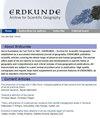Revisiting the spatiotemporal characteristics of past and future global warming
IF 1.1
4区 社会学
Q3 GEOGRAPHY
引用次数: 2
Abstract
It is still an open question, which processes lead to the spatiotemporal specifications of observed near-surface temperature changes over recent decades. Here, we contribute to this debate by investigating a large number of theory-based atmospheric fields referring to the radiation and energy budget and to atmospheric dynamics that may serve as predictors for local temperature changes. The predictors are linked to temperature trends from reanalysis and climate model data, using a sophisticated spatial and temporal statistical model. Temperature changes since the mid-20th century exhibit distinct regional and seasonal differences. After 1990, the near-surface warming rate is more enhanced over landmasses rather than oceans and roughly increases with latitude in both hemispheres. While none of the considered predictors solitarily accounts for the spatial heterogeneity of recent temperature trends, their linear combination largely reproduces the observed cooling pattern during the mid-20th century and the enhanced warming pattern after 1990. This excludes high-altitude areas, sea ice margins and upwelling regions where local feedbacks and nonlinear processes prevail. The leading predictors pertain to radiative processes, especially downward longwave radiation, and changes in sensible heat fluxes. In the low latitudes, dynamical processes such as temperature advection and energy flux divergence also play a role. Until the end of the 21st century, the warming rate and its ocean-land contrast steadily increase. The underlying mechanisms are the same as the ones already established in present-day climate, but near-surface temperature follows more straightly the imposed greenhouse gas scenario. Climate models have different skills in reproducing the observed trend pattern but exhibit more or less the same mechanisms of temperature control.回顾过去和未来全球变暖的时空特征
近几十年来,哪些过程导致了观测到的近地表温度变化的时空特征,这仍然是一个悬而未决的问题。在这里,我们通过研究大量基于理论的大气场来促进这场辩论,这些大气场涉及辐射和能量收支以及大气动力学,可以作为局部温度变化的预测因子。使用复杂的时空统计模型,将预测器与再分析和气候模式数据得出的温度趋势联系起来。20世纪中叶以来的温度变化呈现出明显的区域和季节差异。1990年以后,近地表变暖速率在陆地上而不是在海洋上增强,并且在两个半球大致随纬度增加而增加。虽然所考虑的预测因子都不能单独解释近期温度趋势的空间异质性,但它们的线性组合在很大程度上再现了20世纪中期观测到的降温模式和1990年以后的增温模式。这不包括高海拔地区、海冰边缘和上升流地区,在这些地区,局部反馈和非线性过程占主导地位。主要的预测因子是辐射过程,特别是向下的长波辐射,以及感热通量的变化。在低纬度地区,温度平流和能量通量散度等动力过程也起作用。直到21世纪末,全球变暖速率及其海洋-陆地对比稳步增加。潜在的机制与在当今气候中已经建立的机制相同,但近地表温度更直接地遵循强加的温室气体情景。气候模式在再现观测到的趋势模式方面有不同的技巧,但表现出或多或少相同的温度控制机制。
本文章由计算机程序翻译,如有差异,请以英文原文为准。
求助全文
约1分钟内获得全文
求助全文
来源期刊

Erdkunde
地学-自然地理
CiteScore
2.00
自引率
7.10%
发文量
17
审稿时长
>12 weeks
期刊介绍:
Since foundation by Carl Troll in 1947, ''ERDKUNDE – Archive for Scientific Geography'' has established as a successful international journal of geography. ERDKUNDE publishes scientific articles covering the whole range of physical and human geography. The journal offers state of the art reports on recent trends and developments in specific fields of geography and comprehensive and critical reviews of new geographical publications. All manuscripts are subject to a peer-review procedure prior to publication. High quality cartography and regular large sized supplements are prominent features of ERDKUNDE, as well as standard coloured figures.
 求助内容:
求助内容: 应助结果提醒方式:
应助结果提醒方式:


